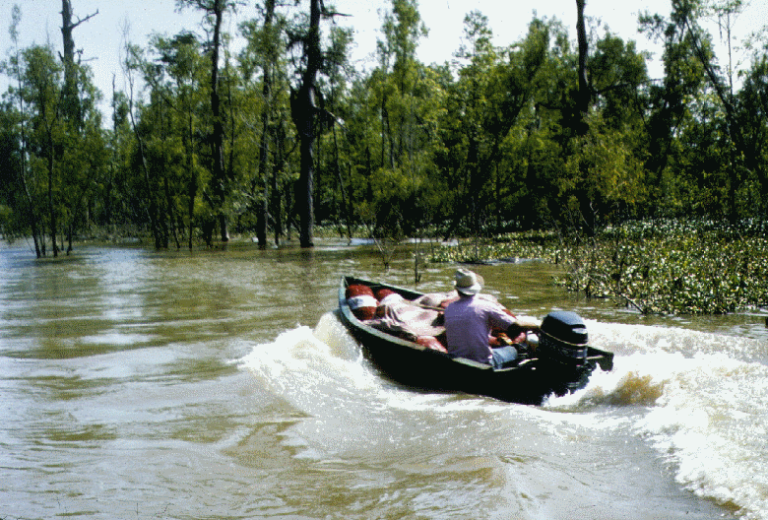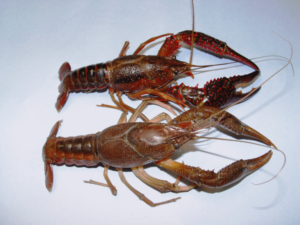Crawfish
Long before rice farmers stocked their ponds to produce crawfish, these tasty crustaceans inhabited the Atchafalaya Basin and other natural wetland habitats in Louisiana. They still do. And in the springtime, commercial fishermen work the bayous and backwater swamps to harvest and deliver millions of pounds of crawfish to the market.

The life cycle of the wild caught crawfish revolves around the natural wet and dry seasons in the wetlands. Typically during the late summer and fall, the swamps of the Atchafalaya dry up and force the crawfish to burrow into holes where they await the next flood. As the snow melts and spring rains flow south and into the Basin, this annual flooding forces the crawfish from their burrows.
Depending on the timing, crawfish emerge with their babies during the winter and populate the habitat. The cold water slows their growth but usually by April, May and June, the young have grown to market size. If sufficient water fills the Basin earlier, fishermen can get into places and harvest some of the older crawfish a month or two before the young of the year crop is ready.
So the “wild” crawfish season depends on the timing and extent of the annual flooding of the Basin. Water gives the crawfish life and water affords access for the fishermen. Generally, one only needs to look at the water level forecast for the Basin during the evening news to judge the volume of crawfish harvested during the spring.
RED and WHITE CRAWFISH

Red swamp crawfish (top) vs white river crawfish (bottom)
To the untrained eye, all crawfish coming out of the boiling pot look alike. Most of them will be the red swamp crawfish that scientist refer to as procambarus clarkii. But a few will be the white river crawfish, technically known as procambarus zonangulus. Most people will never notice as the steam rises from the pile of boiled crawfish on the table surrounded by friends and family.
The white river crawfish have a more elongated claw than the red swamp and will usually be lighter colored, even when boiled. The reds will have a yellow colored “fat” in the head while the whites have a green tinted “fat.” They are both equally delicious.
AVAILABILITY
Wild caught crawfish are most available in April, May and June depending on water level. A limited supply is sometimes harvested earlier if water levels are sufficient to provide access.
Crawfish fact sheet prepared by Mark Shirley, LSU AgCenter/Sea Grant. mshirley@agctr.lsu.edu
Crawfish are sold as a live product in open mesh sacks. When purchasing a sack of crawfish, handle the sack with care and keep in a shaded, cool place until ready to cook. Crawfish can be kept in a cooler overnight or with crushed ice melting through the sack. Sacks of crawfish can be immersed in water to moisten but only for a few minutes. Sacked crawfish left in water for longer can suffocate.
CLEANING
Empty the crawfish into a wash tub to rinse away any mud and remove bits of vegetation or bait that may have fallen into the sack. Change the water two or three times but do not soak the crawfish in the water for more than a few minutes as they will suffocate from lack of oxygen.
PURGING
True purging to empty the digestive track of crawfish takes 12 to 24 hours. Adding salt to the wash water does not purge crawfish.
Crawfish fact sheet prepared by Mark Shirley, LSU AgCenter/Sea Grant. mshirley@agctr.lsu.edu
Cook time will vary slightly depending on the size and the shell condition of the crawfish. Fast growing crawfish with greenish, thin shells will cook faster than larger crawfish with heavy dark colored shells. The critical thing is to bring the internal temperature up to 145 degrees. This will take 3 to 5 minutes once the water returns to a boil. Cooking longer will result in hard-to-peel crawfish. Adding salt to the water will also make them harder to peel.
SEASONING
Seasoning can either be added to the boiling water, added after or both, depending on the “spiciness” desired. Liquid or powdered spices can be added to the boiling water along with other treats like corn, potatoes or even pork sausage. Soaking in the seasoned water lets the spices penetrate. A popular alternative is to place the crawfish in a container and sprinkle with Cajun spices. Cover and let sit for several minutes.
FREEZING
Boiled crawfish can be frozen whole, as unpeeled tails or as peeled tail meat. It takes 7 to 8 pounds of crawfish to yield one pound of tail meat.
NUTRITION
Although crawfish tend to be higher in cholesterol than other seafood, a 3 ounce serving has only 116 miligrams or about a third of the daily recommended allowance. That amount of crawfish meat has only 70 calories and just one gram of total fat. Without the seasoning, it has only 160 grams of sodium.
Crawfish fact sheet prepared by Mark Shirley, LSU AgCenter/Sea Grant. mshirley@agctr.lsu.edu

